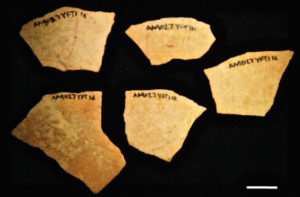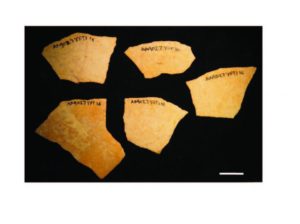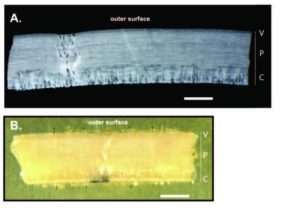
PROCEEDINGS OF THE NATIONAL ACADEMY OF SCIENCES—A method for dating ostrich eggshells in a Middle Stone Age shell midden reveals a more intensely settled and older site than previously known. The stratified layers of shell middens formed from cast-off mussel and limpet shells and other artifacts can offer a window into early cultures. However, radiocarbon dating is accurate to only around 50,000 years. Elizabeth M. Niespolo and colleagues report* a method for dating ostrich eggshells in a Middle Stone Age shell midden and reveal an older site than previously known. The authors explored a method to precisely date older shell middens and thus allow comparisons among midden sites using debris from a common food source. The authors analyzed 17 eggshell samples from five strata of a midden at Ysterfontein 1, a collapsed rock shelter on the western coast of South Africa. Next, the authors measured the concentration of uranium and thorium, accounted for the secondary uptake of uranium upon burial, and estimated that the midden was formed 119,900- 113,100 years ago. Analysis of stable carbon, oxygen, and nitrogen isotopes within the eggshells offered insight into the paleoenvironment, indicating a cooling and drying climate. According to the authors, the accumulation rates of debris within the midden are more akin to those from the Later Stone Age, indicating that humans were intensively foraging marine resources.
______________________________

Ancient ostrich eggshells from Ysterfontein 1, a Middle Stone Age midden in South Africa. Shown are selected eggshells from the top layer of the midden dated by Uranium- Thorium (U-Th, or 230 Th/U) geochronology, with their outer surfaces facing up. Scale bar is 1 cm. Elizabeth M. Niespolo
______________________________

A. Thin section photomicrograph of a modern ostrich eggshell in cross section, and corresponding eggshell structures denoted by V (vertical layer), P (palisade or prismatic layer), and C (cone layer). Pores serving as oxygen pathways for incubating chicks are visible as open holes penetrating through the eggshell. B. Epoxy-mounted fragment of an ancient eggshell from Ysterfontein 1 in cross section, showing the same eggshell structures are well preserved in deep time. Analyses from laser ablation are evident along pitted lines and track concentrations of U and Th. A pore is apparent in the center of the mounted fragment. Scale bars are 1 mm. Elizabeth M. Niespolo
______________________________
Article Source: PNAS news release
*”Early, intensive marine resource exploitation by Middle Stone Age humans at Ysterfontein 1 rockshelter, South Africa,” by Elizabeth M. Niespolo, Warren D. Sharp, Graham Avery, and Todd E. Dawson
______________________________
Advertisement





